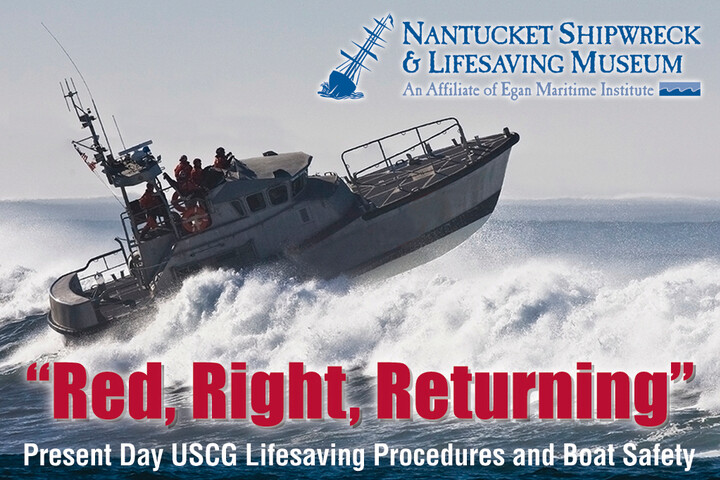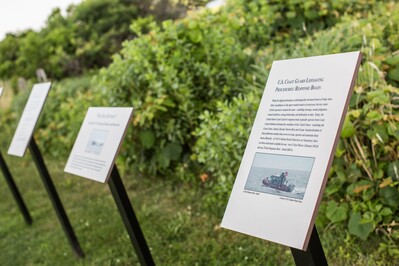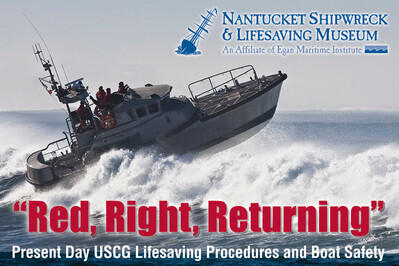
Egan Maritime Institute’s Nantucket Shipwreck & Lifesaving Museum will open on Thursday, May 23 with a new exhibit “Red, Right, Returning”, which honors and explores in-depth present day United States Coast Guard lifesaving procedures and boat safety. The exhibit features present day lifesaving procedures and an everyday guide to boat safety. Nine separate panels bordering the property of the Museum along the edge of Folgers Marsh allow visitors a lovely view of the water and a chance to read and enjoy a plethora of information and photographs pertaining to boat safety and USCG lifesaving procedures.
Whether you have been at sea in a professional capacity or simply on board as a recreational boater, it is understood that the rules of the water remain the same. “Red, Right, Returning" – probably the most common and important navigational directive known today – is just one of the many tips and terms shared in this exhibit. The two main types of Aids to Navigation are buoys and beacons that indicate the port and starboard sides of a route to be followed. Virtually all U.S. markers follow the traditional 3R rule of “Red, Right, Returning.” This means, when returning from sea, you must keep red Aids on the right-hand (starboard) side of the boat. These Aids have even numbers, and the numbers should increase as you proceed inland.
Some of the other boat safety tips and reminders offered on the panels in this exhibit are:
- Do not operate a boat under the influence of alcohol. Several hours of exposure to powerboat noise, vibration, sun, glare, wind and motion produces a kind of boater’s hypnosis.
- Have complete knowledge of the operation and handling characteristics of your boat.
- Make sure safety equipment, required by law, is on board and that you know where it is stored, that it is maintained in good condition, and that you know how to properly use these devices.
By Federal Law, you must have the following on board:
- USCG-approved personal flotation device (PFD) for each person – easily accessible
- At least one USCG-approved portable fire extinguisher, if fuel tank or engine is enclosed
- Sound producing device – such as a horn or a whistle – capable of making an “efficient sound signal” audible for one-half mile
To complement the outdoor exhibit, a six-person life raft is available for both children and adults to try out. The raft is designed to give visitors the unique experience and genuine feeling of what it might be like to be confined to a small lifesaving vessel. At USCG Station Brant Point on Nantucket, there are three rescue boats available for use: two 47-foot Motor Lifeboats (MLB) and one 25-foot Response Boat – Small (RB-S).
The MLB is designed as a fast response rescue resource in high seas, surf, and heavy weather environments. The distribution of buoyancy in the deckhouse and mast platform, combined with the low center of gravity, allows the MLB to self-right in less than 30 seconds. It is the ideal platform for operations in extreme sea conditions. With its longer range, durability and superb capabilities, it is the primary Search and Rescue asset at the Brant Point Station. The RB-S is a multi-mission platform assigned to Maritime Safety and Security Teams, the Maritime Security Response Team, Marine Safety Units and to boat stations throughout the USCG. Primarily used for Law Enforcement and Tactical Operations, the RB-S is also the boat of choice for near-shore and shallow water Search and Rescue response. While the high-performance, technologically advanced boats of today bear little resemblance to the open wooden boats used in the past, the key traits of their operators remain the same – unfailing courage, sound judgment, trained initiative, strong leadership, and dedication to duty.
In addition to the outdoor exhibit, the 2012 exhibition, "Guiding Lights: Nantucket's Lighthouses, Keepers & their Families," remains in the Alison and Bill Monaghan Gallery inside the Museum. To learn more about this exhibit, click here.
With much appreciation and gratitude to:
- EganSign
- MK2 Samuel Freedman/USCG Station Brant Point
- Suzanne Gardner
- CDR Maurice E. Gibbs USN (Ret.)
- Sheila Lucey/Nantucket Harbormaster
- Louise Martling/Eleventh Hour Design
- Stefanie Joy Muscat/Bevara
- Chief William Pittman/Nantucket Police
- Sharlene Rudd
- BM3 Alex Spinney/USCG Station Brant Point
- BMCS Matthew T. Welsh/USCG Station Brant Point

